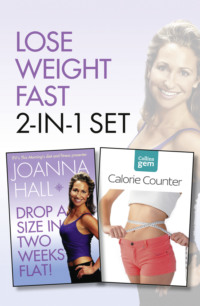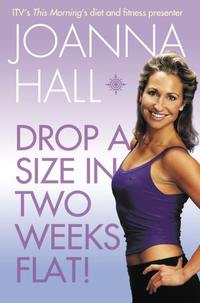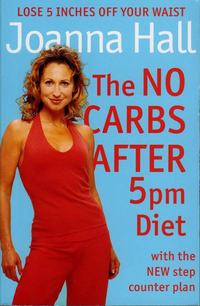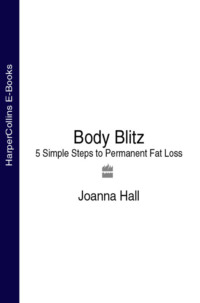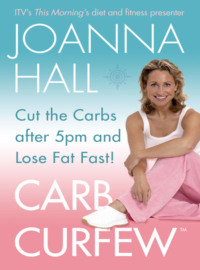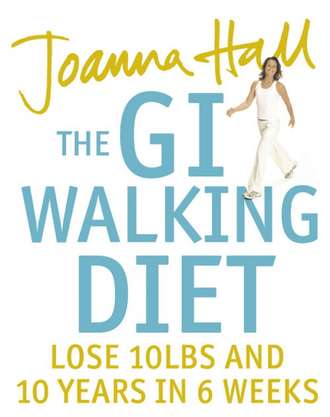
Полная версия
The GI Walking Diet: Lose 10lbs and Look 10 Years Younger in 6 Weeks
Physiological Effects of Ageing
Resting Metabolic Rate
Your resting metabolic rate (RMR) is the amount of calories your body requires just to live. It’s determined by your weight and the amount of muscle and body fat you have. As we age, RMR tends to decline. This is partly due to decreased muscle mass. It’s also affected by changes to your nervous system, specifically the sympathetic nervous system (SNS), slowing the response time between brain messages and muscle movement. Resting metabolic rate is what most people mean when they say ‘basal metabolic rate’ (BMR). These two terms are used interchangeably, although they are not technically the same.
As part of the normal ageing process, most body organs decrease in functional capacity, resulting in a 2 per cent decline in BMR each decade. However, if physical activity also declines, BMR will decrease more quickly, and there will be a greater increase in fat mass. This means that, over time, your metabolic rate slows down, and weight gain will occur unless you decrease the amount of calories you consume and increase your level of physical activity. Your metabolic rate may also decrease as the cardiovascular, gastrointestinal and respiratory systems slow down with age, which can influence digestion, absorption and nutrition needs.
What This Means to You
The biggest impact of a reduced RMR is that you will find it more difficult to maintain a healthy weight, and you may experience weight gain.
What You Can Do
Experts are divided on how much weight gain is a product of the natural ageing process and how much is attributable to other factors, such as decreased energy expenditure through physical activity. But one thing’s certain: decreased physical activity results in less muscle mass, which in turn impacts upon your RMR or the rate at which the body burns calories. But it doesn’t have to be like this …
Action Worth Investing In
By following the six-week plan, specifically the walking and strength programme, you can feel confident that you will lose weight.
VO2 MAX
Most researchers who have evaluated the effects of ageing on the stamina of the heart and lungs have focused on ‘maximal aerobic fitness’ or VO2 MAX. This refers to the body’s maximum ability to take in oxygen, transport it around the body in the blood and use it to burn fuel in the muscles. This is considered to be the single best indicator of the changes that occur in the body with ageing. After 25 years of age, VO2 MAX normally declines at a rate of 8 to 10 per cent per decade for both men and women. Approximately half of this decrease has been related to people exercising less and gaining weight as they age.
We all tend to have different VO2 MAX values. Athletes have very high values, meaning that their bodies are better able to take in oxygen and use it to produce energy. Normal people have more average levels. With age, however, nature takes its toll on all of us and we all experience a decrease in our VO2 MAX.
What This Means to You
A lowering in your VO2 MAX can cause a decrease in your performance, your everyday ‘huff and puff’. Physical tasks that seemed easy now require a little more effort. You may feel out of breath and that you don’t have enough energy. But it doesn’t have to be like this …
What You Can Do
At any age, if you exercise vigorously and keep lean you can have a much higher VO2 MAX. Research has shown that athletes aged from 65 to 75 can have the VO2 MAX of young sedentary adults and are capable of performing at levels once thought physically unattainable.
But we do have to be realistic. Even among older athletes who exercise vigorously throughout their lives, VO2 MAX will still eventually decline. The important point, however, is that the rate of decline will be much slower. A US study examining former elite long-distance runners over a 22-year period found that regardless of how much they trained, all did eventually lose aerobic fitness; but (and this is a big BUT) the rate of decline may be lessened for up to 20 years if an individual takes regular vigorous endurance exercise.
Action Worth Investing In
You’ll find that the six-week walking plan can have a significant impact on your cardiovascular fitness. It will give you more huff and puff and loads more energy. If you combine it with the six-week menu plan, you’ll lose 5–10 per cent of your excess weight. Your clothes will fit better and you will look younger.
Oestrogen
For women, oestrogen plays a significant role in controlling calcium absorption and retention in the bones, so when it starts to decline it can have a big impact on the body.
What This Means to You
Without adequate oestrogen, women over the age of 50 are at increased risk of osteoporosis, stress fractures or broken bones. In addition, research is showing how calcium has a vital role in helping the body burn fat. The exact mechanism is not entirely understood but studies have shown that when people consume inadequate amounts of calcium, the body stores more fat, resulting in weight gain. But it doesn’t have to be like this …
What You Can Do
Most experts say that calcium should come from the diet. (For details of good dietary calcium sources.) Resistance training is an excellent way for women of all ages to stimulate and maintain bone growth. Hormone replacement therapy, although once considered promising, now appears to have little or no positive effect on bone mass growth.
Action Worth Investing In
Following the six-week menu plan will help boost your calcium intake, while just by completing the six-week strength plan twice a week, you’ll experience big improvements in your physical capacity, body tone and strength.
Other Hormones
Many hormones play a significant role in the body. As we age, hormonal changes can affect us in many ways. You will come across a number of them in this book – here is an overview of the most important ones.







Intestinal Bacteria
Our intestinal bacteria can play a role in weight gain as we age. Atrophic gastritis is a bacterial infection marked by a decreased ability to produce sufficient amounts of gastric acids. This condition occurs in 24 per cent of people aged 60–69 years, 32 per cent of people aged 70–79 and about 40 per cent of people over the age of 80.
What This Means to You
Low-acidic conditions in the stomach can affect the absorption of nutrients such as folic acid, vitamin B12, calcium, iron and betacarotene.
What You Can Do
If you suffer from atrophic gastritis, you are usually advised to get adequate calories by eating small meals throughout the day or by snacking on nutrient-dense foods. You should avoid nutrient-poor choices such as commercial biscuits and cakes. Medication may also be prescribed for this condition. Speak to your doctor if you feel you may be suffering from intestinal bacteria problems. Symptoms include bloating, discomfort and poor digestion.
Action Worth Investing In
The six-week menu plan and all the recipes are designed to provide you with an optimum nutrition plan that is both enjoyable and easy to adapt to your lifestyle, whether you are entertaining or looking after the family.
Connective Tissue
Ageing brings about stiffening of the connective tissue such as your tendons and ligaments. This leads to a loss of mobility.
What This Means to You
This may make your joints feel stiff, affecting your mobility and ability to react physically and move the way you want. When walking, you may experience an increased postural sway – moving the upper body from side to side – which affects your stride length, gait and balance. When gait and balance are affected, the risk of falling increases. But it doesn’t have to be like this …
What You Can Do
Improving your mobility is a simple and highly effective way to improve your range of motion and your quality of movement.
Action Worth Investing In
You’ll find your mobility action plan invaluable.You can do it every day, and in fewer than 14 days you’ll notice a difference in how your body feels; and after three weeks you’ll notice a big improvement in how it moves. You’ll also find the tips on walking technique helpful for enhancing mobility.
Body Stages
The body is on a journey. Like any journey,
the ride may not always be smooth.
For women in particular, hormones play a large part in the changes we notice as we get older. However, men also see their bodies changing as they pass through different stages in life.
Peri-menopause
Peri-menopause is defined as the time leading up to menopause. For some women, this can be eight to ten years before the onset of the menopause itself. Marked by a fluctuation of hormones, it is often described as a roller-coaster ride since the decline in hormones is erratic rather than steady.
During peri-menopause, many women experience a range of symptoms, including:






At this stage in their lives, women also experience a drop in metabolism, owing to changes in hormones and muscle mass. This means their bodies require fewer calories to perform normal everyday tasks, and slowly this contributes to weight gain. Oestrogen levels become more erratic, waxing and waning, which causes fat to be stored in the abdomen. Consequently, any weight gain is laid down around the middle, and so middle-age spread is born!
Erratic levels of the hormone oestrogen cause fat to be stored around the abdomen – and so middle-age spread is born!
Peri-menopause is a critical period for a woman’s health. During this time, healthy habits – like regular exercise, good nutrition and an element of stress management – are vital to prepare for the next stage of your life, and to help you handle the physiological and associated emotional changes being experienced.
How the GI Walking Diet Can Help
Follow the six-week plan and you will make a great investment in your health. The structure of the programme will help you form good habits, while all the tips along the way will show you how these physical investments can fit easily into your lifestyle.
Menopause
Menopause is defined as the 12 months after a woman’s final menstrual period, which is usually around the age of 52. Although we tend to think of menopause as a single point in the body’s journey, both peri-menopause and menopause are more like peaks and troughs than finite events. After menopause, women lose about 66 per cent of their oestrogen and 50 to 60 per cent of their testosterone. Oestrogen tends to decline at a faster rate than testosterone, and so testosterone can start to have a greater effect on the body. In most cases, body fat is redistributed from the hips to the midriff. This ‘shape-shifting’ phenomenon compounds the middle-age spread that you may have started to experience during peri-menopause. Blood pressure and cholesterol levels rise. The loss of oestrogen’s protective influence on bone tissue leads to decreases in bone mineral density. On average, women lose 2 per cent of bone mass each year during menopause, yet it is possible to lose up to 20 per cent of bone in the five to seven years after menopause.
While all these changes are happening inside the body, women can experience a range of unpleasant symptoms such as:





Some of the physical effects of menopause – weight gain, the ‘shape-shifting’ scenario and changes in blood pressure and cholesterol – can put women at a higher risk of cardiovascular disease.
How the GI Walking Diet Can Help
The six-week walking plan will be particularly valuable for your health. You don’t have to be super fit – just head to The Walking Plan and you can choose a starting level to suit you. It really is that simple to start walking off your weight.
The Window of Opportunity Years
The ‘window of opportunity years’ are a time of choice – when you can choose to open the window and experience the benefits of health and fitness. As women move beyond the menopause, and men reach their mid-50s and 60s, normal changes to the body include:




With age, women lose more bone than men and so are more susceptible to fractures from falling. Balance training and fall-prevention programmes, such as those in this book, are extremely beneficial to women and men, especially in this ‘mature’ stage of life. Some people are more likely to experience depression, loneliness and apprehension about change at this life stage. If you are not used to exercising, you may lack confidence about taking up a new activity.
The normal, effects of ageing are compounded by a sedentary lifestyle.
How the GI Walking Diet Can Help
The mobility and strength programmes of the six-week plan will be invaluable. You don’t have to spend hours doing them; they literally take minutes and you will reap significant benefits for your body. Many people may be widowed at this stage of life, and exercise offers a great opportunity to meet other people and socialize. Physical activity is known to have a positive effect on depression and mood, so get moving.
Aches and Pains
Some conditions, such as osteoporosis and arthritis, become more prevalent in later life, bringing us aches and pains. When these symptoms come to the surface, you may worry about how much exercise is actually achievable for you. However, the six-week programme addresses these concerns and allows you to tailor your programme to your abilities and needs. We look at some of the most common causes of aches and pains below.
Osteoporosis
Osteoporosis is a skeletal disease characterized by low bone mass, increased bone fragility and risk of fracture. Women are four times more likely to develop osteoporosis than men. Osteoporosis fractures occur most commonly in the hip, spine and wrist. Osteoporosis is often referred to as a silent disease because a fracture is frequently the first indication of bone loss.
How the GI Walking Diet Can Help
Diet and exercise can be both a treatment and prevention, as they help make your bones stronger. The impact to the bones due to walking makes it a great bone-saving exercise, so regular walking will help maintain strong bones. In addition to reducing bone loss, walking will improve muscle strength, balance, agility and fitness, making falls and fractures less likely. You should start slowly and gradually increase the amount you walk each week.
Walking has other life-enhancing psychological and cardiovascular benefits. Increased activity can aid nutrition, too, because it boosts appetite, which is often reduced in older people. It is also important to get enough calcium and vitamin D in your diet. The biggest reason older people don’t get enough of these is that they simply don’t eat enough.
Arthritis
The term ‘arthritis’ refers to more than a hundred different diseases that cause pain, swelling and limited movement in joints and connective tissue throughout the body. Arthritis is usually a long-term condition, often lasting a lifetime. The three most prevalent types of arthritis are osteoarthritis, fibromyalgia and rheumatoid arthritis (see below).
Arthritis and other rheumatic conditions affect an estimated one in seven people. The number one cause of disability, arthritis can limit everyday activities such as dressing, climbing the stairs, getting in and out of bed and walking.
Overweight people are at greater risk of developing arthritis in their knees, hips and hands. The heaviest individuals have seven to ten times the risk of developing osteoarthritis of the knee. Weight control helps by decreasing the pressure on the knees and hips. Your walking technique can also reduce the force you apply through your hips and knees. We’ll address this in Form and Posture with the really simple glass of water exercise.





